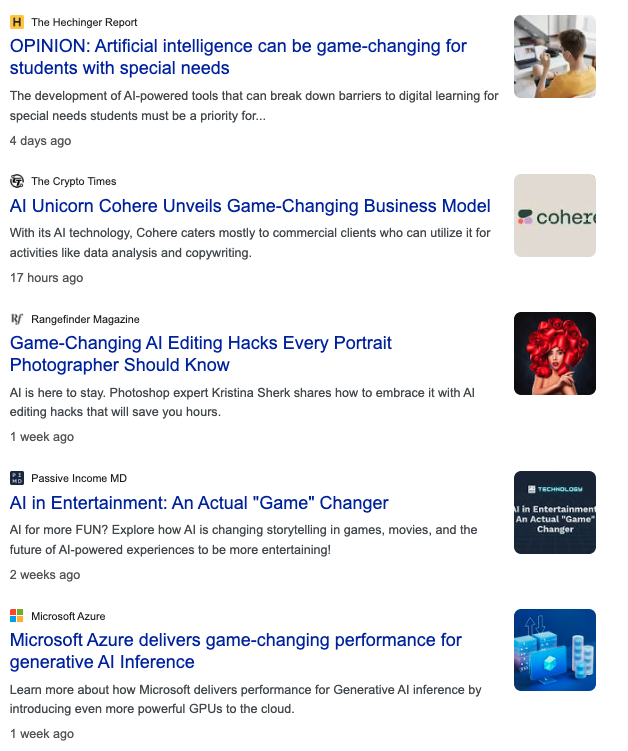Do we really need to use generative AI tools?
P.S. Lab Notes are written for and organized by Persona Types👤 persona types – we wanted to sort our content by the way people think and not across topics, because most topics are beneficial for people of all different backgrounds in product building. Our method allows for readers to hone in on what suits them, e.g. via perspective, lessons learned, or tangible actions to take. .
Following the exploration of generative AI’s implications for organizations and its environmental footprint, our focus shifts to its influence on individual professionals. Despite the widespread integration of AI across various sectors, a notable gap exists in guiding people to upskill⬆️ upskill – to further one’s learning or enhance skills relevant to their current role, or towards adjacent roles in effort to career-pivot. Particularly relevant to technology as we have new technology emerging in AI. Upskilling may not be enough, or so claims an article in Harvard Business Review, “Reskilling in the Age of AI”, that favors emphasizing need for “reskilling”. and learn AI tools. Recognizing this, we aim to provide more tangible ways to use AI tools in upcoming lab notes.
In this lab note, we address the shortage of resources on using generative AI tools versus building them. We also delve into reasons to use AI and the further benefits that individuals can derive from its adoption.
👇 Skip the context. Jump to questions.

Understanding Current AI Trends in Business and Talent
Before we dive deeper, it’s crucial to frame our discussion with an overview of the current narratives shaping AI in the professional world.
AI in the Business Realm
- Investment Surge: Major corporations are funneling vast resources into developing AI models, with investments reaching into the hundreds of millions.
- Tech Foundation: The backbone of generative AI—rapidly advancing semiconductor technologies—is crucial yet continually evolving.
- AI Everywhere: A competitive push is on to embed AI capabilities directly into everyday devices, aiming for AI assistants that are as ubiquitous as smartphones and cars.
AI and Talent Dynamics
- High-Stakes Recruitment: Finding skilled professionals to manage sophisticated AI systems is both challenging and costly, given the scarcity of such expertise amidst intense competition.
- The Future of Work: Growing anxieties over job security and the intrinsic value of human labor are heightened by the automation potential of AI and frequent news of job cuts.
As Individuals, We Have Questions About AI
👉 A tip for readers: use the questions below to quickly jump to the other sections.
- What are reasons generative AI adoption is low for individuals?
- Do we really need to AI Upskill?
- Should using AI lead to building AI?
A Book That Predicted ChatGPT-like Growth
One of the goals of our lab notes is to ensure we are documenting our responses to what we’ve been reading about in the product and technology sphere. While one goal is to be able to reference the ideas, another critical component is to draw connections to previous materials we’ve interacted with. This solidifies and strengthens the knowledge index, or “second brain🧠 second brain – a method for indexing what you know, experienced, or learned for future reference, especially useful for stuff easily forgotten yet is the basis of your future beliefs. This is an idea coined by Tiago Forte and illustrated and written about by Maggie Appleton while taking a course on it. This concept is adjacent in philosophy to digital gardens. “, we create.
Throughout, I’ll be drawing insights from the book, Superforecasters: The Art and Science of Prediction, published in 2015, a period preceding the widespread media buzz about AI. This exploration is part of my effort to bridge my own digital and physical reading, particularly around the questions: “Is using AI necessary, and if so, how should we approach it?” You’ll see references to David Ferrucci, a notable figure in the field of artificial intelligence, recognized for his significant contributions at IBM.
I’ll also be quoting this book in a related lab note, discussing the topic of human value of labor and whether AI threatens it.
Q: What are reasons generative AI adoption is low for individuals?
Let’s examine the key reasons, especially for those outside of deeply technical roles:
- AI Talent War: The rush by companies to adopt generative AI for competitiveness has sparked a significant talent shortage, focusing on builders/developers rather than users. This intense focus misaligns with the needs of most professionals seeking to enhance workflows through AI usage.
- Noisy Environment: The AI discussion is cluttered, making it difficult for professionals to find straightforward information on utilizing AI strategically. “Search engine noise,” as a Quora user puts it, exacerbates the challenge, with keyword ambiguity obscuring helpful resources.
- Uncharted Territory: With AI’s continuous evolution, establishing clear best practices and understanding ROI are ongoing challenges. Our collective journey towards maximizing AI’s potential is still in its infancy.
- Fear of Access: The marketing of AI as a “game-changing” innovation has paradoxically deterred engagement due to intimidation, despite its design for simplicity. Many are also unsure about the basics, like how to access or set up these tools, which is simpler than perceived.
-
Practical Usage Over Hype: Utilizing AI tools like chatGPT often simplifies to tasks as straightforward as copy/paste, challenging the notion of AI as solely “cutting-edge.” Stay tuned as I break down these applications in future articles.
AI as a “Game Changer”… is that impacting individual perceptions?
I decided to run a Google Search for “AI is game changing” under the “News” tab to see what would come up. Endless pages of results poured in, from very recent days to requiring quite a bit of pagination to reach a few quarters into the past. The results spanned all sorts of industries, media buzz and opinion, investment news, etc.
To narrow it down, I used “Tools” to select the timeframe of the past week. 6 Pages! Most were within the last day or so. To me, the search confirmed that this is a prominent view of AI. The results also demonstrate that the dialogue around it can be speculative and confusing, if not at least exciting for some of the advancements.

Try the search yourself – to see if it is still a similar experience for you. Let me know in the feedback form at the bottom if you notice anything interesting, as there was quite the array of impacted industries and angles being spun around how AI was, indeed, game-changing.
For example, one of the results broached the topic of AI in agriculture:
“Machine learning algorithms are the digital scarecrows guarding a treasure of efficiency and abundance. They work silently behind the scenes, analyzing the ebbs and flows of climate data, soil nutrition, and crop cycles to forecast yields with uncanny accuracy. This digital augury is a game changer in the arcadian arenas, as shared by platforms like agriculture.com, where data-driven agriculture has taken root.”
Google Result: When Silicon Meets Soil: AI as Earth’s Game Changer in the Quest for Sustainable Abundance
While the article I quoted above is pretty literary, I happened to recall a documentary I watched months ago that also covered the topic. If you want to learn more, I highly recommend watching this video, “Sniper robot treats 500k plants per hour with 95% less chemicals“.
FOMO may be preventing individuals adopting AI
I could see how not being involved in deeply technical work, the concept of generative AI is elusively abstract and could create fear of missing out over such a pivotal, emerging technology. Ironically, I do know many people who are highly technical and still resist using AI, though I think this may improve as we learn more about the variety of ways to use AI and industries ripe for innovation (agricultural pun intended).
🧐 Are you someone who has not yet accessed chat-based generative AI tools?
Well, for those eager to dive in now, sign up at chat.openai.com (Angela’s favorite) or explore Claude.ai (Grey’s favorite) and discover the accessible, immediate utility of AI tools. P.S. Our endorsements are based on our genuine experiences, not affiliation!
Deliberately not using AI? Not allowed at your job? 🤫 Tell us using our feedback form at the bottom of this lab note, so we can discuss!

Q: Do we really need AI Upskilling?
Emphatically, yes. The intimidation factor associated with AI, particularly its perceived complexity, often deters usage. Yet, the essence of generative AI lies in its conversational design, making it accessible to all.
Exploring AI’s impact, it’s noticeable there’s limited insight on the ROI companies achieve from AI deployment. Large corporations are facing challenges, as creating and implementing AI systems is costly and complex. In Computer World’s analysis of Gartner’s research, they predict that by 2025, a significant portion of AI projects in large enterprises will either slow down or be discontinued due to costs outweighing benefits.
On the flip side, the outlook for smaller entities and individuals is more optimistic. Despite the difficulties faced by larger organizations, surveys indicate that most business leaders who have adopted AI tools are seeing positive outcomes. For instance, from the same article referenced above, ChatGPT has been linked to a 37% increase in worker productivity, and AI coding assistants have improved productivity by 7% to 55%.
This suggests that for small and medium-sized businesses, freelance professionals, and operational managers, leveraging AI tools can offer immediate and significant benefits. They can bypass the extensive costs and complexities, directly tapping into AI’s potential to streamline tasks and enhance skills efficiently.
Using AI chat-based assistants will be a mainstay, like “Office Suite” proficiency is today.
A compelling reason for starting to use generative AI tools is that it is already becoming a desired resume skill. However, as AI proficiency becomes a baseline expectation in professional settings, akin to Office suite skills, integrating AI into daily workflows is not just advantageous but necessary.
…machine learning, in combination with burgeoning human-machine interactions that feed the learning process, promises far more fundamental advances to come. “It’s going to be one of these exponential curves that we’re kind of at the bottom of now,” Ferrucci said.
In the above quote, the anticipation of profound advancements in AI and human-machine collaboration was ironically forecasted in “Super Forecasters.” This emphasizes the critical nature of engaging with AI now. The book’s 2015 “bottom of the curve” prediction of an exponential growth trajectory for AI and machine learning, fueled by increasingly sophisticated human-machine interactions, has proven prescient, highlighting the imperative to adapt and upskill.
Q: Should using AI lead to building AI?
Deciding whether to develop AI tools or utilize existing ones hinges on your career vision and the practical landscape of the AI field. Building AI tools is currently a highly sought-after skill, setting a foundation for individuals to lead their own ventures and possibly find fulfillment beyond the attractive paychecks of big tech firms.
Yet, shifting careers towards AI development faces substantial barriers, including the high costs of technology, a job market favoring experienced professionals, and the rapid pace of innovation, making it challenging for many to embark on this path.
Nonetheless, leveraging AI tools in your daily workflow offers a tangible and immediate benefit, allowing for skill enhancement and efficiency improvements without the necessity of deep technical expertise in AI development. It’s beneficial to first get acquainted with these tools and understand their potential impact from a practical standpoint.
If you start to notice natural curiosity to improve your prompt-engineering, desiring ownership over your models, or simply having big ideas for AI-driven entrepreneurial pursuits, then moving towards building AI tools could be for you. 🤓 Psst…If you’re into this already, please send us links you’ve found useful to get started in building generative AI tools. “Slide into our email DM’s” using our feedback form at the bottom of this lab note!
Stay Tuned: Exploring Actual ChatGPT Conversations
Generative AI is still developing, there’s not that much information on how to measure ROI especially for individuals, and the detailed methods for using AI in workflows is not that ground-breaking.
For example, what AI has looked like for me in daily usage is simple enhancements to workflows that involve copy/paste, tedious manipulations of words, back and forth chats no one would want to read, swapping between applications. How do you explain that? So much of the usage is about the concepts and goals underlying the generative AI input and the resulting transformative output will only ever mirror that, or worse. I plan to write about this next, where I will analyze over 200 conversations I’ve had with ChatGPT, born from natural usage and curiosity.




